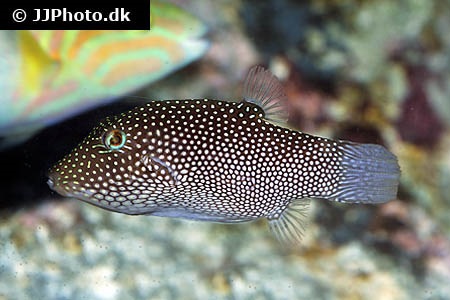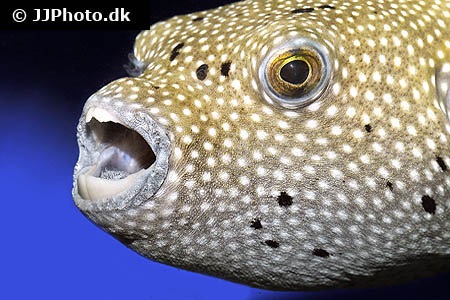Arothron meleagris


| Latin name | Arothron meleagris - (Anonymous, 1798) |
|---|---|
| Local name | Arothron Puffer |
| Family | Tetraodontidae - Arothron |
| Origin | East Indian Ocean, West Indian Ocean, Australia, Indonesia, East Pacific, Central/West Pacific |
| Max length | 50 cm (19.7") |
| Minimum volume |
2000 l (528 gal) |
|---|---|
| Hardiness |
Average |
| Suitable for aquarium |
Suitable with care |
| Reef safe |
Not reef safe |
| Aggressiveness | Mostly peaceful but might be aggressive towards similar species |
| Recommended |
Larger crustaceans (Shrimp, crabs...) Other invertebrates Small crustaceans (Krill, mysis, artemia...) |
|---|---|
| Mostly |
Large polyp stone coral (LPS) Small polyp stone coral (SPS) Soft coral Sponges |
This species eats shrimps, crayfish, crabs, small bivalves, sea urchins, snails and similar.
These fish must not suck in air when they are being fed or transported, as they have difficulties expelling it again.
This species has a toxin in its skin, which it releases when highly stressed or dying.
This poison can kill all the aquatic life in the aquarium, if unlucky.
These fish require food which helps to prevent overgrowing teeth. e.g. clams.
If their teeth grow too much, it might necessitate grinding them down, however this is a very stressful procedure.
One must avoid catching Pufferfish with a net, as there is a risk of it "puffing" itself up, whilst being in it.
It can be fatal if it "puffs" itself up when out of the water, as it will have trouble getting rid of the air again.
If it is stuck in the net it is necessary to cut it free.
When transported, the Pufferfish can release a poison, so avoid emptying this water into the aquarium.
This species often has a fun and interesting personality.
These fish will change colour during 3 different phases of their life.
They can be black with white spots or yellow/brown or white/black markings.
Pufferfish (Tetraodontidae) are known for their unique way of swimming, their very interesting personality and of course their ability to puff up. It is not a coincidence that so many aquarists fall for these funny fish.
In nature, pufferfish blow water onto sand to find food, hence they are also called "Blowfish". They will sometimes do this in the aquarium. In addition to this they will also spray water out of the tank, so do not be suprised if they do :-)
Site electrical equipment with care.
Many of the species have spines, but these can normally only be seen when the fish is puffed up.
They are not generally reef safe, and will sometimes nibble at the fins of the other fish. They are, on the other hand, very hardy and if ones purchases a healthy specimen it can live for many years under good conditions.
One must be careful when handling and transporting the fish, as many of the species will release a toxin into the water.
They are described as being difficult to keep, but if one has the correct equipment and food, it is indeed possible. Something to be aware of with Pufferfish is that they demand a lot of food, so the aquarium must be able to handle this. They require food which grinds their teeth, as they keep on growing through out their life. The fish is unable to eat if their teeth grow too long. Suitable foods are snails or mussels.
Flake foods are not suitable for pufferfish even though they will eat it. It must be supplemented with a varied selection of seafood and frozen foods.
When selecting a pufferfish at the fish store, one must be aware of parasites, as these are quite common among them. These may show up as white spots or small irregularities in the skin. They can also have internal parasites which can only be avoided by quarantining the fish.
See more about feeding, selecting and diseases in John Champlin's article.
| Aquarium trade | Yes |
|---|---|
| Distribution | Indo-Pacific: East Africa south to Durban, South Africa (Ref. 4919) and east to the Panama, north to Ryukyu Islands, south to Lord Howe and Easter islands. Eastern Pacific: Guaymas, Mexico to Ecuador (Ref. 9349). |
| German common names |
Weisstüpfel-Kugelfisch |
| English common names |
White-spotted balloon Whitespotted pufferfish Guineafowl puffer Guinea-fowl pufferfish |
John Champlin. Puffer Care and Information - Reefnut.com (web.archive.org) - (English)
Bob Fenner. All My Puffers, Tobies, Box, Porcupine, Cowfishes - Wet Web Media - (English)

